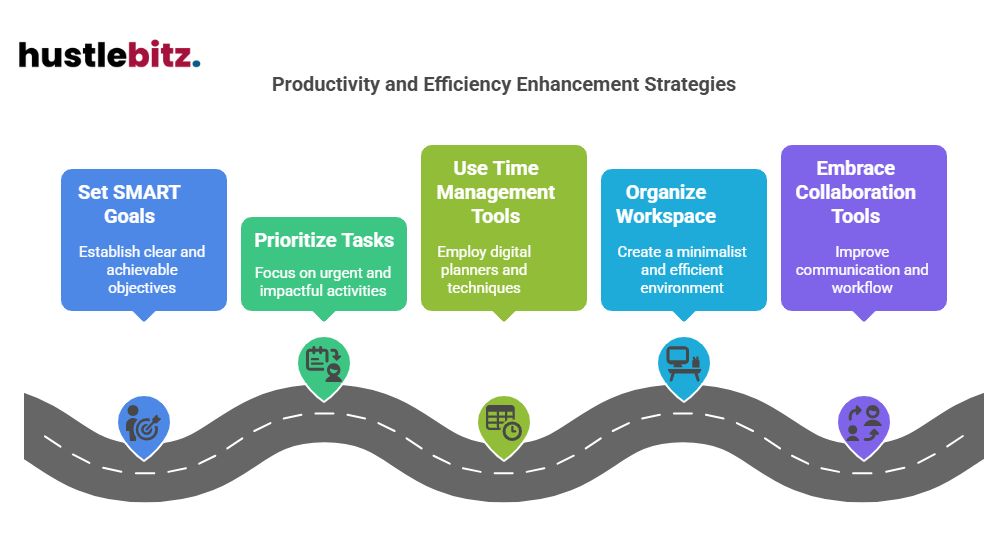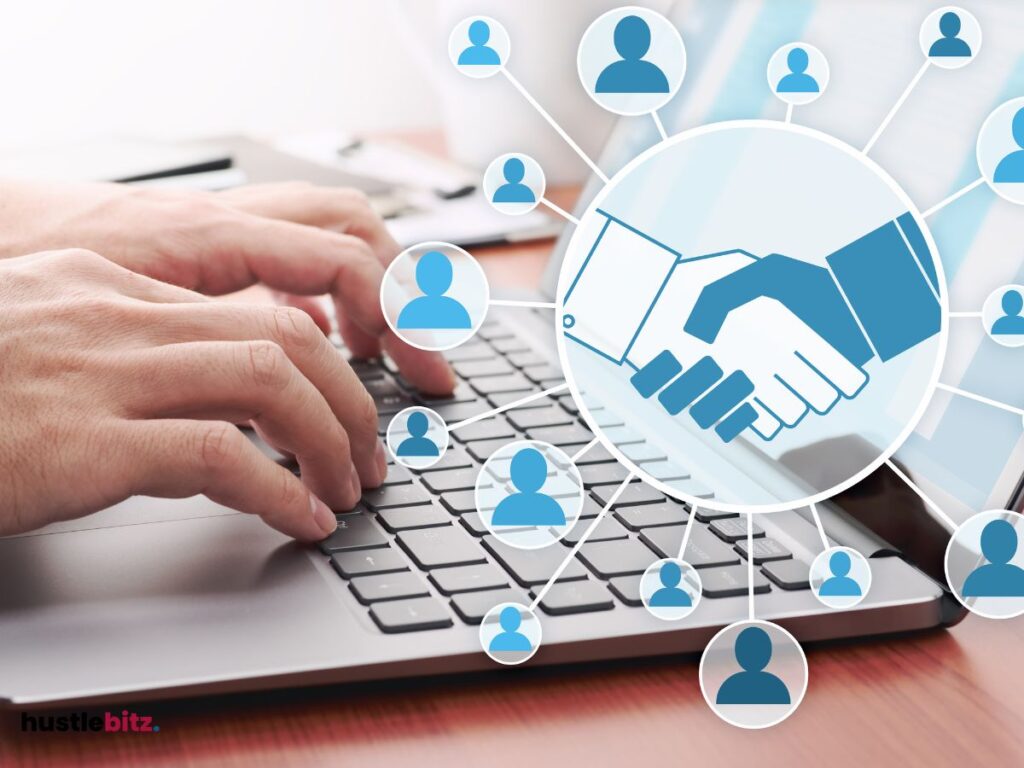Improving efficiency at work involves several practical strategies. Begin by setting clear, SMART goals to provide direction and foster accountability. Prioritize tasks using a structured approach, such as a priority matrix, to manage workloads effectively. Utilize time management tools, like digital planners and the Pomodoro technique, to enhance focus. An organized workspace is essential; minimize distractions and streamline document management. Automate repetitive tasks to free up time for more strategic efforts. Embrace collaborative tools to enhance communication and teamwork. Incorporating regular breaks can also rejuvenate mental faculties. Discover additional methods to enhance your workplace efficiency as you explore further.
Key Takeaways
- Set SMART goals to provide direction and enhance accountability, ensuring clarity and commitment in your tasks.
- Prioritize tasks using a matrix to focus on urgent and impactful activities, preventing burnout through workload balancing.
- Utilize time management tools like digital planners and the Pomodoro technique to enhance focus and productivity.
- Organize your workspace with a minimalist design and effective filing systems to foster creativity and reduce distractions.
- Embrace collaboration tools and regular feedback loops to improve communication, accountability, and continuous workflow improvement among team members.

Set Clear Goals

Setting clear goals is essential for enhancing work efficiency, as it provides direction and measurable benchmarks for success. Effective goal setting involves defining SMART objectives—Specific, Measurable, Achievable, Relevant, and Time-bound—that align with both short-term milestones and a long-term vision. This structured approach ensures that individuals and teams can track their progress towards achieving desired outcomes.
Incorporating measurable outcomes into the goal-setting process fosters accountability and encourages commitment. Establishing accountability partners can further enhance motivation, as shared responsibilities create a support system that encourages regular check-ins and progress tracking. These partners can provide essential feedback loops, allowing individuals to assess their progress and make necessary adjustments.
To maintain momentum, it is crucial to implement motivation strategies that resonate with each team member. Celebrating small victories along the way reinforces a sense of achievement, while alignment check-ins help ensure that everyone remains focused on the overarching goals. By regularly revisiting objectives, teams can adjust their strategies as needed, keeping their efforts aligned with the long-term vision.
Ultimately, setting clear goals not only enhances individual work efficiency but also contributes to a culture of collaboration and success within the organization. As employees see their efforts translate into measurable outcomes, they are more likely to stay engaged and committed to their work, driving overall productivity.
Prioritize Tasks Effectively
Effectively prioritizing tasks is crucial for maximizing productivity and ensuring that essential activities are addressed in a timely manner. By employing structured approaches, individuals can enhance their ability to navigate their workload efficiently.
Here are some effective strategies to prioritize tasks:
- Urgency Assessment Techniques: Evaluate tasks based on their deadlines and potential impact. This helps distinguish between what is urgent and what is important, facilitating better decision-making frameworks.
- Priority Matrix Usage: Utilize a priority matrix to categorize tasks into four quadrants: urgent and important, important but not urgent, urgent but not important, and neither urgent nor important. This visual representation aids in recognizing where to focus efforts first.
- Workload Balancing Methods: Distribute tasks evenly to avoid burnout. Implement task delegation strategies to share responsibilities and ensure that critical tasks are not overlooked.
- Daily Reflection Practice: At the end of each day, review accomplishments and adjust priorities for the next day. This reflective practice fosters long-term planning and helps track project milestones effectively.
Utilize Time Management Tools

To further enhance productivity, incorporating time management tools can significantly streamline task execution and optimize overall work efficiency. These tools not only help in managing time effectively but also facilitate better organization, ensuring that deadlines are met and tasks are completed without unnecessary stress.
A variety of time management tools are available, each serving unique purposes. For instance, time blocking allows individuals to allocate specific periods for focused work, while digital planners help in organizing daily activities. Task timers can be employed through techniques such as the Pomodoro technique, which encourages productive focus sessions interspersed with short breaks, ultimately enhancing concentration.
Additionally, integrating project management tools with calendar integration features can streamline workflows by providing deadline reminders and tracking progress on various tasks. The use of productivity apps facilitates better task prioritization and allows users to visualize their workload, leading to improved workflow optimization.
Here is a table summarizing some effective time management tools:
| Tool Type | Purpose |
| Time Blocking | Allocate specific time for tasks |
| Digital Planners | Organize daily activities |
| Task Timers | Manage time for focused work |
| Project Management | Track project progress and deadlines |
| Productivity Apps | Enhance task prioritization |
Organize Your Workspace

An organized workspace is essential for fostering productivity and minimizing distractions, enabling employees to focus on their tasks more efficiently.
Implementing effective workspace decluttering techniques can significantly enhance the atmosphere, allowing for a clearer mind and improved workflow. A well-structured environment not only boosts morale but also encourages creativity.
Here are four practical strategies to optimize your workspace:
- Ergonomic Workstation Setup: Invest in furniture that supports good posture and reduces physical strain. An ergonomic chair and adjustable desk can enhance comfort, leading to prolonged focus and efficiency.
- Minimalist Desk Design: Adopt a minimalist approach by removing unnecessary items from your desk. Keep only essential tools within reach to facilitate a distraction-free work environment.
- Effective Filing Systems: Organize physical and digital documents using effective filing systems. Categorize files logically and utilize digital organization strategies to ensure quick retrieval and reduce clutter.
- Optimizing Storage Solutions: Maximize your available storage by using vertical space and multi-functional furniture. Consider creative workspace inspiration such as wall-mounted shelves or under-desk storage to maintain a tidy area.
Automate Repetitive Tasks

Automating repetitive tasks can significantly streamline workflows and free up valuable time for employees to focus on more strategic initiatives. By leveraging task automation benefits, organizations can enhance productivity and minimize human error. Software automation tools are essential for achieving this, as they allow companies to automate various tasks, from automating email responses to more complex processes like robotic process automation.
Implementing workflow automation strategies can transform how teams operate, particularly in areas such as automating data entry and automating repetitive reporting. For instance, automation in project management tools can ensure that deadlines are met without the need for constant manual updates.
Scheduling automation solutions further simplify calendar management, allowing employees to allocate their time more effectively.
Moreover, the benefits of automation extend beyond just time savings. By reducing the burden of mundane tasks, employees can dedicate their efforts to higher-value activities that require critical thinking and creativity.
This shift not only improves job satisfaction but also enhances overall business performance.
Embrace Collaborative Tools

Leveraging collaborative tools can further enhance workplace efficiency by facilitating seamless communication and teamwork among employees. In today’s fast-paced work environment, especially in contexts involving remote teamwork, utilizing digital platforms is essential. These tools not only streamline project management but also foster an inclusive culture that encourages innovation and productivity.
To maximize the benefits of collaborative tools, consider the following strategies:
- Utilize Cloud Collaboration Tools: Employ platforms like Google Drive or Dropbox for effective file sharing. This ensures all team members can access necessary documents in real-time, promoting transparency and reducing delays.
- Conduct Virtual Meetings: Use video conferencing tools such as Zoom or Microsoft Teams for regular check-ins. This enhances team communication and helps maintain personal connections among remote workers.
- Implement Feedback Loops: Encourage open feedback through tools like Slack or Asana. This facilitates continuous improvement and allows for quick adjustments in project direction.
- Organize Brainstorming Sessions: Use platforms like Miro or Trello for interactive brainstorming sessions. These tools allow for task delegation and help visualize ideas collectively, making the creative process more efficient.
Take Regular Breaks
Incorporating regular breaks into the workday can significantly enhance overall productivity and focus. Research has shown that taking mindful breaks allows individuals to recharge their mental faculties, leading to improved efficiency. Breaks can come in various forms, from power naps to stretching exercises, each offering unique benefits.
For instance, a brief power nap can refresh the mind, while stretching exercises can alleviate physical tension and promote circulation. Engaging in nature walks not only provides a change of scenery but also fosters a connection to the environment, which can be invigorating. It’s essential to include hydration reminders throughout the day, as proper hydration is vital for maintaining cognitive function.
Furthermore, implementing a digital detox during breaks can help clear mental clutter, allowing employees to reset and refocus. Social interactions during breaks can enhance team camaraderie and improve morale, contributing positively to the workplace atmosphere. Incorporating breathing techniques can also facilitate relaxation and reduce stress, which is essential for maintaining productivity levels.
Lastly, creative downtime is equally important, as it enables individuals to think outside the box and generate innovative ideas. By prioritizing regular breaks, employees can achieve necessary mental resets, leading to sustained focus and enhanced work performance. Embracing these strategies not only benefits individual productivity but also contributes to a healthier, more engaged workplace culture.
Final Thoughts
Improving efficiency at work is all about combining thoughtful planning, smart tools, and healthy habits. By setting clear goals, prioritizing tasks, and using time management techniques, you can boost your productivity. An organized workspace and the automation of repetitive tasks also free up time for more meaningful work. Collaborating with others through digital tools and taking regular breaks for mental clarity are equally important for maintaining high levels of performance. Ultimately, adopting these practical tips creates a balanced and productive work environment that can lead to long-term success.




